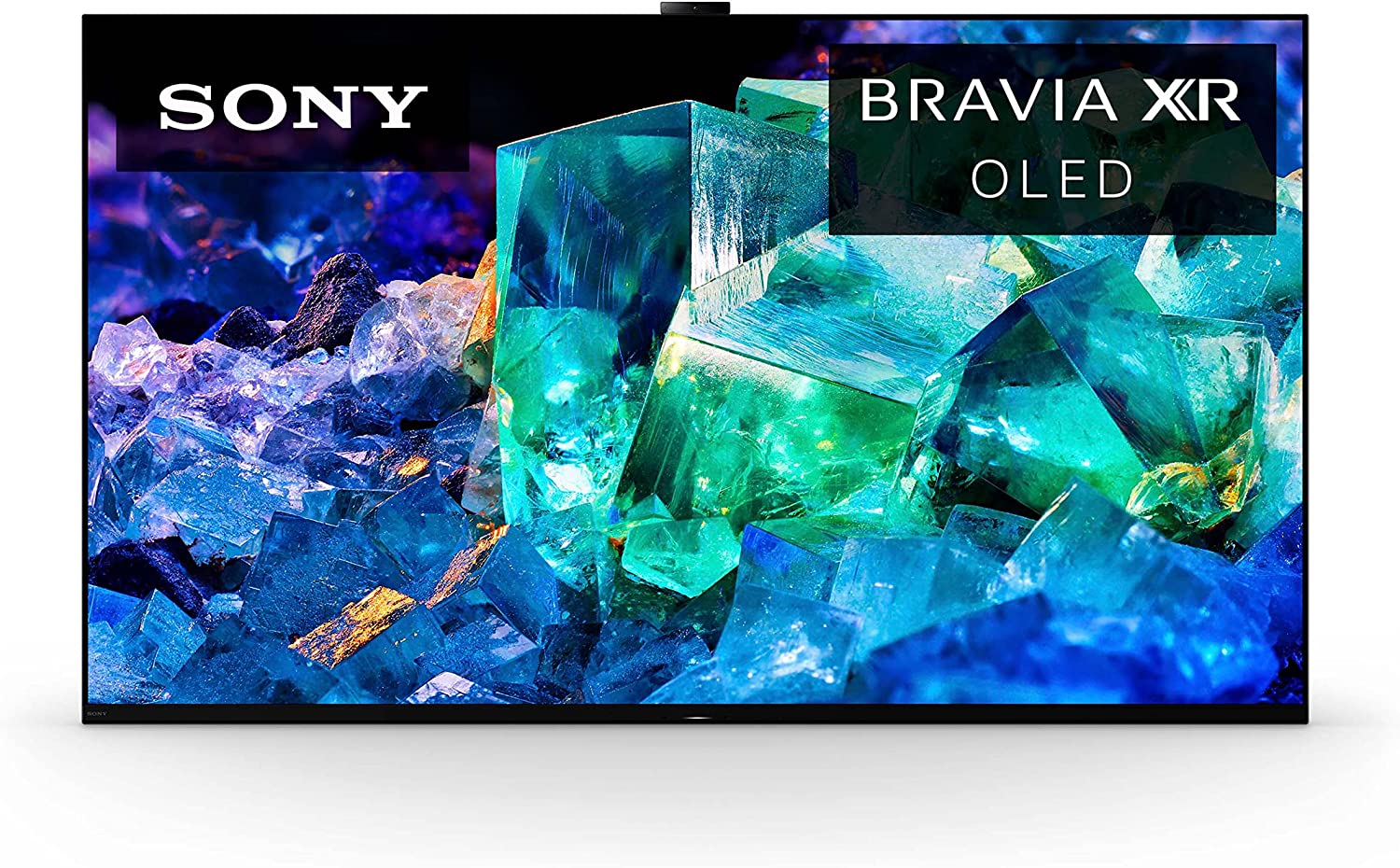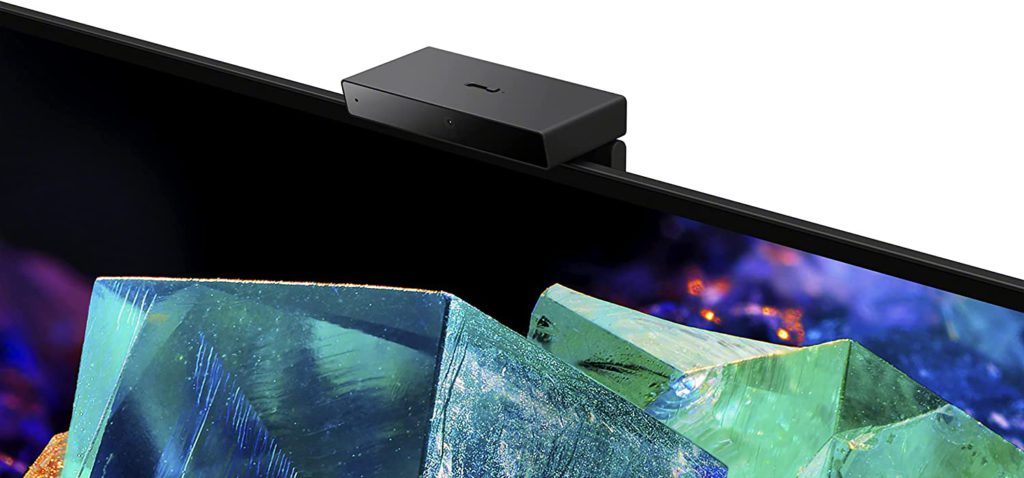*** TVReviewland.com earns commissions on qualifying purchases made through affiliate links ***
Check out this Sony A95K review to see what happens when OLED and Quantum Dot tech combine.
Sony positions the A95K as a statement piece that’s a cut above other OLED product lines. The idea is to leverage quantum dot components to deliver peerless color accuracy and brighter images. What you get is a QD-OLED panel with lots of bells and whistles. Let’s see if the impressive hardware translates to picture quality that shows up in your typical, high-end OLED TV.
Sony A95K review: Design and build
The top third of the Sony A95K is as slim as your smartphone, which is as far as the OLED aesthetic goes. An enclosure full of TV circuitry piggybacks off the main panel, expanding the TV to a thickness of 1.7 inches. This is still slim enough for a wall-mount setup, but you may want to consider the alternative.
Sony chooses a solid base for the A95K, and the result is edgy décor for your entertainment stand. The base can extend forward, which allows the TV to sit flush against a wall. It also extends backward to create an illusion where the TV magically holds itself upright without legs. The only downside to the design is that the A95K leaves zero room for a soundbar.
Now to the back panel, which has a grid-pattern texture, a wall-mount pattern, and two sets of ports. Sony provides three covers that you can use to hide the ports’ cables.
Controls and connectivity
The Sony A95K has ultra-thin borders on three sides, which gives the screen a frameless look. A thicker bottom bezel houses far-field microphones, buttons, an IR receiver, and the Sony logo.
HDMI 2.1 ports let you enjoy high-frame-rate content from your gaming console and other external devices. The A95K has two such ports, but one of them doubles as an eARC port. Connecting a sound output device through this eARC port effectively leaves you with one available HDMI 2.1 port.
In addition to a pair of HDMI 2.1 ports, the Sony A95K also comes with:
- Two HDMI 2.0 ports
- Optical digital output
- Ethernet jack
- Cable/antenna connector
- A few USB ports
Bluetooth and WiFi connectivity comes from a dual-band wireless adapter. This allows you to share content from your devices, your home network, and anywhere in your living space.
[Read what others have to say about this television]
Smart TV platform
Sony uses the Google TV platform for many of its smart TV product lines, including the A95K. The Google/Android interface comes with a large selection of streaming apps and valuable tools. You also get convenient features like:
- Google Homekit
- Chromecast and Apple Airplay2
- A function for video calls with the webcam that ships with the TV
- Hands-free voice commands with Alexa or Google Assistant
- A rich menu that lets you adjust the picture settings of the A95K
Sony A95K review: How a QD-OLED panel works
What does a Quantum Dot-OLED combination look like, you ask? For starters, a QD-OLED TV lacks an LED backlight and relies on OLED layers that emit blue light. The blue light passes through microscopic quantum dot filters that shift the blue wavelengths to different colors.
In this configuration, one pixel from the OLED component combines with two or three Quantum dots to form a larger, multi-color pixel. The QD-OLED pixel then uses its different components to render colors that match the digital signal it receives.
Sony A95K review: Hardware and picture quality
From the previous section, we see that the OLED layer is the backlight for the Sony A95K. The 120Hz QD-OLED panel has a vast color gamut that provides enough material for accurate, life-like hues. Note that the quantum dot component of the A95K is reactive to light, and there may be slight color shifts in very bright rooms.
The Sony A95K is brighter than your average OLED TV but dimmer than comparable LED displays. Still, the TV manages to execute excellent contrast and deliver popping highlight detail. HDR content looks vivid, with just enough color saturation to create realistic skin tones in all kinds of scene lighting.
Here’s how the TV holds up according to different performance metrics:
Color accuracy
The A95K does an excellent job of color reproduction, with minimal difference between what appears on the screen and its digital source. An extensive color palette provides enough material for high-fidelity hues from the A95 QD-OLED TV. The real-world result is clear Caribbean waters with shades of aqua that look exactly like real life. Add some HDR detail to this image, and it’ll feel like you’re on an actual tropical boat ride.
Brightness, contrast, and HDR content
Multiple OLED layers make the Sony A95K brighter than your average OLED screen. Also, the QD component of the panel channels the light towards your eyes with minimal absorption or deflection.
On the other end of the spectrum, OLED pixels can go dark to create deep blacks and stark contrast. The A95K process uses this impressive contrast ratio to deliver:
- Brilliant highlight detail
- Contouring, texture, and shadow detail
- Clever depth and 3D simulation
Remember that with the Sony A95K, you give up the complete darkness of a regular OLED panel for brighter images. The tradeoff is worth it, as a fiery sunset lights up the different shades of ocean-blue, Caribbean water. You could almost feel the breeze nudging the light to weave and glide across the gentle waves.
Motion handling
The A95K has low input lag and nimble pixels that change color in less than 15ms. This translates to minimal motion lag, smooth navigation, and enjoyable gameplay. The 120Hz refresh rate and HDMI 2.1 ports also help to render perfect fast-action content. Gamers will appreciate the VRR and auto-low latency functions that the HDMI 2.1 ports offer.
Pros
- Vast color gamut
- Beautiful execution of HDR content
- HDMI 2.1 ports allow for 4K/120 content
- Rock solid build and an excellent design
- Google TV platform delivers a good user experience
- The far-field microphone allows for hands-free voice commands with Alexa and Google Assistant
- The TV comes with a camera that you can use for video chats
- Excellent remote with backlighting and audio location
Cons
- Installing the TV on an entertainment stand leaves no room for a soundbar
- The QD layer in the A95K prevents the TV from reaching OLED black levels of zero nits
- You may notice a little color shift when bright ambient light hits the screen
- Sony needs to add more HDMI 2.1 ports to their TVs
Sony A95K review verdict: It makes the leaderboard
The Sony A95K should appear on several shortlists of flagship televisions to consider. For starters, the A95K is more expensive than QD-OLED televisions with similar specs and performance. This QD-OLED panel from Sony is pretty heavy, despite its sleek frame. The A95H also delivers excellent HDR pictures, and few models can compare.
So, should you splurge on a QD-OLED widescreen from Sony? This Sony A95K review says that the TV has plenty going for it. Click here to learn more about this television.
Read more:
Samsung HW-Q990B Review: Knocks It Out of The Ballpark
Bestisan Soundbar Review for the Shopper Who Likes to Keep it Simple
Samsung Q60BD Review: Can A Budget QLED TV Deliver?
Alienware 17in Laptop Review for Gamers and Other Heavy Users
Sony X95K Review: Does Well on All Counts




